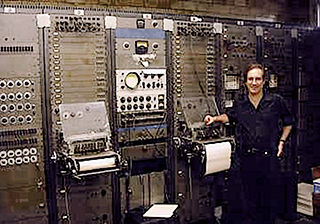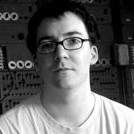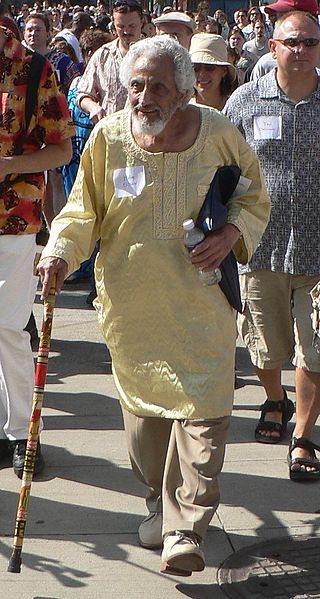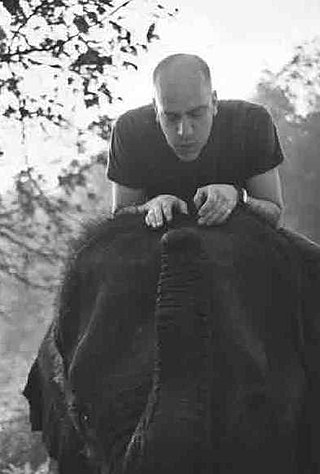Related Research Articles
Electronic music broadly is a group of music genres that employ electronic musical instruments, circuitry-based music technology and software, or general-purpose electronics in its creation. It includes both music made using electronic and electromechanical means. Pure electronic instruments depended entirely on circuitry-based sound generation, for instance using devices such as an electronic oscillator, theremin, or synthesizer. Electromechanical instruments can have mechanical parts such as strings, hammers, and electric elements including magnetic pickups, power amplifiers and loudspeakers. Such electromechanical devices include the telharmonium, Hammond organ, electric piano and electric guitar.

An electronic musical instrument or electrophone is a musical instrument that produces sound using electronic circuitry. Such an instrument sounds by outputting an electrical, electronic or digital audio signal that ultimately is plugged into a power amplifier which drives a loudspeaker, creating the sound heard by the performer and listener.
Paul Lansky is an American composer.

ChucK is a concurrent, strongly timed audio programming language for real-time synthesis, composition, and performance, which runs on Linux, Mac OS X, Microsoft Windows, and iOS. It is designed to favor readability and flexibility for the programmer over other considerations such as raw performance. It natively supports deterministic concurrency and multiple, simultaneous, dynamic control rates. Another key feature is the ability to live code; adding, removing, and modifying code on the fly, while the program is running, without stopping or restarting. It has a highly precise timing/concurrency model, allowing for arbitrarily fine granularity. It offers composers and researchers a powerful and flexible programming tool for building and experimenting with complex audio synthesis programs, and real-time interactive control.
MUSIC-N refers to a family of computer music programs and programming languages descended from or influenced by MUSIC, a program written by Max Mathews in 1957 at Bell Labs. MUSIC was the first computer program for generating digital audio waveforms through direct synthesis. It was one of the first programs for making music on a digital computer, and was certainly the first program to gain wide acceptance in the music research community as viable for that task. The world's first computer-controlled music was generated in Australia by programmer Geoff Hill on the CSIRAC computer which was designed and built by Trevor Pearcey and Maston Beard. However, CSIRAC produced sound by sending raw pulses to the speaker, it did not produce standard digital audio with PCM samples, like the MUSIC-series of programs.

Max Vernon Mathews was an American pioneer of computer music.
The Computer Music Center (CMC) at Columbia University is the oldest center for electronic and computer music research in the United States. It was founded in the 1950s as the Columbia-Princeton Electronic Music Center.

The RCA Mark II Sound Synthesizer was the first programmable electronic synthesizer and the flagship piece of equipment at the Columbia-Princeton Electronic Music Center. Designed by Herbert Belar and Harry Olson at RCA, with contributions by Vladimir Ussachevsky and Peter Mauzey, it was installed at Columbia University in 1957. Consisting of a room-sized array of interconnected sound synthesis components, the Mark II gave the user more flexibility and had twice the number of tone oscillators as its predecessor, the Mark I. The synthesizer was funded by a large grant from the Rockefeller Foundation.
Perry R. Cook is an American computer music researcher and professor emeritus of computer science and music at Princeton University. He was also founder and head of the Princeton Sound Lab.
Paul Moravec is an American composer and a University Professor at Adelphi University on Long Island, New York and also a member of the composition department of the Mannes School of Music. Already a prolific composer, he has been described as a "new tonalist." He is best known for his work Tempest Fantasy, which received the 2004 Pulitzer Prize for Music. Among his compositions are two operas: The Letter (2009) and The Shining (2016).

Roger Luke DuBois is an American composer, performer, conceptual new media artist, programmer, record producer and pedagogue based in New York City.

Halim Abdul Messieh El-Dabh was an Egyptian-American composer, musician, ethnomusicologist, and educator, who had a career spanning six decades. He is particularly known as an early pioneer of electronic music. In 1944 he composed one of the earliest known works of tape music, or musique concrète. From the late 1950s to early 1960s he produced influential work at the Columbia-Princeton Electronic Music Center.
A laptop orchestra or laptop ensemble (LE) is a chamber music ensemble consisting primarily of laptops. Education based laptop orchestras include SCLOrk , BLOrk, CLOrk, CMLO, HELO, L2OrkOLO, PLOrk, SLOrk, SAMPLE, and ELUNM (Ensamble de Laptops de la Universidad Nacional de Música in Peru. City based laptop orchestras include BiLE, MiLO, and BSBLOrk, MLOrk, LOrk•A.
AudioMulch is modular audio software for making music and processing sound. The software can synthesize sound and process live and pre-recorded sound in real-time.

Sebastian Currier is an American composer of music for chamber groups and orchestras. He was also a professor of music at Columbia University from 1999 to 2007.

A synthesizer is an electronic musical instrument that generates audio signals. Synthesizers typically create sounds by generating waveforms through methods including subtractive synthesis, additive synthesis and frequency modulation synthesis. These sounds may be altered by components such as filters, which cut or boost frequencies; envelopes, which control articulation, or how notes begin and end; and low-frequency oscillators, which modulate parameters such as pitch, volume, or filter characteristics affecting timbre. Synthesizers are typically played with keyboards or controlled by sequencers, software or other instruments, and may be synchronized to other equipment via MIDI.
Douglas Geers is an American composer, and the founder of the Spark Festival.

David Sulzer is an American neuroscientist and musician. He is a professor at Columbia University Medical Center in the departments of psychiatry, neurology, and pharmacology. Sulzer's laboratory investigates the interaction between the synapses of the cerebral cortex and the basal ganglia, including the dopamine system, in habit formation, planning, decision making, and diseases of the system. His lab has developed the first means to optically measure neurotransmission, and has introduced new hypotheses of neurodegeneration in Parkinson's disease, and changes in synapses that produce autism and habit learning.
Nina C. Young is an American electro-acoustic composer of contemporary classical music who resides in New York City. She won the 2015 Rome Prize in musical composition, a 2021 Guggenheim Fellowship, and a 2014 Charles Ives Prize from the American Academy of Arts and Letters.
Georg Essl is an Austrian computer scientist and musician, who works in the areas of human-computer interaction, acoustics, mobile computing and mobile music. He is a visiting research professor at the College of Letters & Sciences at the University of Wisconsin–Milwaukee, and he is also affiliated with the Center for 21st Century Studies. Prior to that he was an assistant professor at the University of Michigan.
References
- ↑ "What is CMIX?". Princeton University. Archived from the original on 2008-08-21. Retrieved 2008-07-14.
- 1 2 3 "Brad Garton". Columbia University. Archived from the original on 2008-05-09. Retrieved 2008-07-14.
- ↑ "Brad Garton". Columbia University Department of Music. Retrieved 2023-01-31.
- ↑ Garton, Brad (May 2005). "Another Part of the Two Square Miles". Columbia University . Retrieved 2008-07-14.
- ↑ Garton, Brad. "Brad Garton misc. page". Columbia University . Retrieved 2008-07-14.
- ↑ Garton, Brad. "Brad Garton Music". Columbia University.
- ↑ "Brad Garton, February 2007 | Institute for Advanced Study". University of Minnesota Institute for Advanced Study. February 1, 2007. Archived from the original on 2013-11-04. Retrieved 2012-12-01.